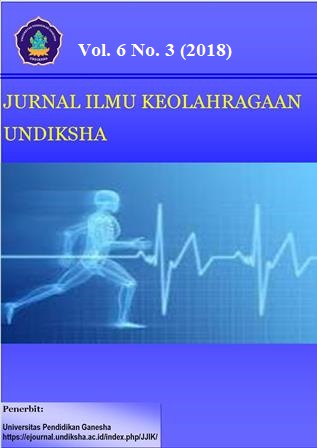PENGARUH PELATIHAN LANGKAH BAYANGAN (SHADOW) MEMINDAHKAN BOLA BULUTANGKIS TERHADAP KELINCAHAN DAN DAYA LEDAK OTOT TUNGKAI
DOI:
https://doi.org/10.23887/jiku.v6i3.3691Abstract
Penelitian ini bertujuan untuk mengetahui pengaruh pelatihan langkah bayangan (shadow) memindahkan bola bulutangkis terhadap kelincahan dan daya ledak otot tungkai. Jenis penelitian adalah eksperimen semu dengan rancangan the non randomized pretest-posttest control group design. Subjek penelitian sebanyak 20 orang. Kelincahan diukur dengan tes zig-zag run, dan untuk daya ledak otot tungkai menggunakan tes vertical jump, selanjutnya data dianalisis dengan bantuan komputer program SPSS 16.0. Hasil analisis data kelincahan pada kelompok perlakuan langkah bayangan terjadi peningkatan rata-rata gaint score sebesar 0,49 dan pada kelompok kontrol terjadi peningkatan rata-rata gaint score sebesar 0,25. Hasil analisis data daya ledak otot tungkai pada kelompok perlakuan langkah bayangan terjadi peningkatan rata-rata gaint score sebesar 9,1 dan pada kelompok kontrol terjadi peningkatan rata-rata gaint score sebesar 5,0. Hasil uji t-independent variabel kelincahan antara kelompok perlakuan dan kelompok kontrol didapat Thitung sebesar 5,082 dengan signifikansi 0,000 dan untuk variabel daya ledak otot tungkai antara kelompok perlakuan dan kelompok kontrol didapat Thitung sebesar 6,403 dengan signifikansi 0,000. Dari hasil analisis data dan pembahasan dapat disimpulkan bahwa; (1) pelatihan langkah bayangan (shadow) memindahkan bola bulutangkis berpengaruh terhadap peningkatan kelincahan pada siswa putra ekstrakurikuler bulutangkis SMP Negeri 1 Ubud. (2) pelatihan langkah bayangan (shadow) memindahkan bola bulutangkis berpengaruh terhadap peningkatan daya ledak otot tungkai pada siswa putra ekstrakurikuler bulutangkis SMP Negeri 1 Ubud.Kata Kunci : Langkah Bayangan (shadow), kelincahan, daya ledak otot tungkai
The aims of this study was to determined the effect of training shadow step moving a shuttlecock to the agility and leg muscle power. Type of research was quasi experiment with the non randomized pre-test-post-test control group design. This research as many as 20 subjacts. Agility measured with a zig-zag run test and Leg muscle power measured with a vertical jump tests, then the data were analyzed with the aid of a computer program SPSS 16.0. The results of the analysis of agility on a shadow step treatment group, the mean of gaint score increased of 0,49, in the control group there was an increase of 0,25. The result of the analysis of leg muscle power on a shadow step treatment group, the mean of gaint score increased of 9,1, in the control group there was an increase of 5,0. The results of t-Independent agility variables between the treatment and control groups obtained Taccount of 5,082 with significance 0,000, leg muscle power variables between the treatment and control groups obtained Taccount of 6,403 with significance 0,000. From the results of the data analysis and discussion, it can be concluded that; (1) shadow step training effect on the increase in agility men's badminton extracurricular of SMPN 1 Ubud. (2) shadow step training effect on the increase in leg muscle power men's badminton extracurricular of SMPN 1 Ubud.
keyword : shadow step, agility, leg muscle power
Published
2018-10-18
How to Cite
Saputra, G. R., Budiawan, M. B., & Tisna, G. D. (2018). PENGARUH PELATIHAN LANGKAH BAYANGAN (SHADOW) MEMINDAHKAN BOLA BULUTANGKIS TERHADAP KELINCAHAN DAN DAYA LEDAK OTOT TUNGKAI. Jurnal Ilmu Keolahragaan Undiksha, 6(3), 11–18. https://doi.org/10.23887/jiku.v6i3.3691
Issue
Section
Articles
License
Authors who publish with the Jurnal Ilmu Keolahragaan Undiksha agree to the following terms:- Authors retain copyright and grant the journal the right of first publication with the work simultaneously licensed under a Creative Commons Attribution License (CC BY-SA 4.0) that allows others to share the work with an acknowledgment of the work's authorship and initial publication in this journal
- Authors are able to enter into separate, additional contractual arrangements for the non-exclusive distribution of the journal's published version of the work (e.g., post it to an institutional repository or publish it in a book), with an acknowledgment of its initial publication in this journal.
- Authors are permitted and encouraged to post their work online (e.g., in institutional repositories or on their website) prior to and during the submission process, as it can lead to productive exchanges, as well as earlier and greater citation of published work. (See The Effect of Open Access)










